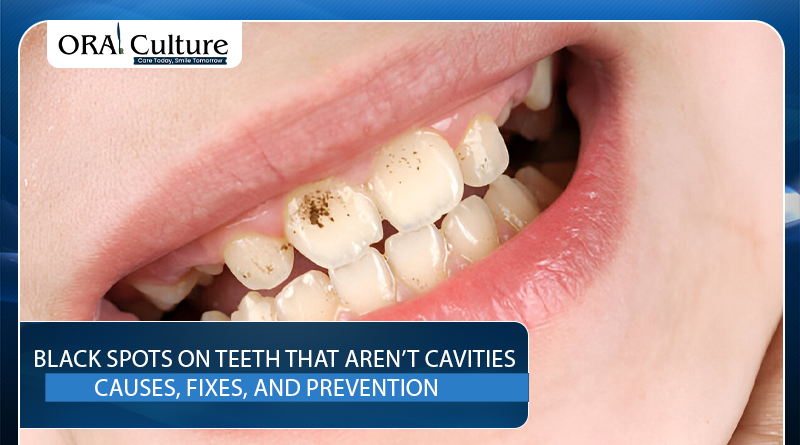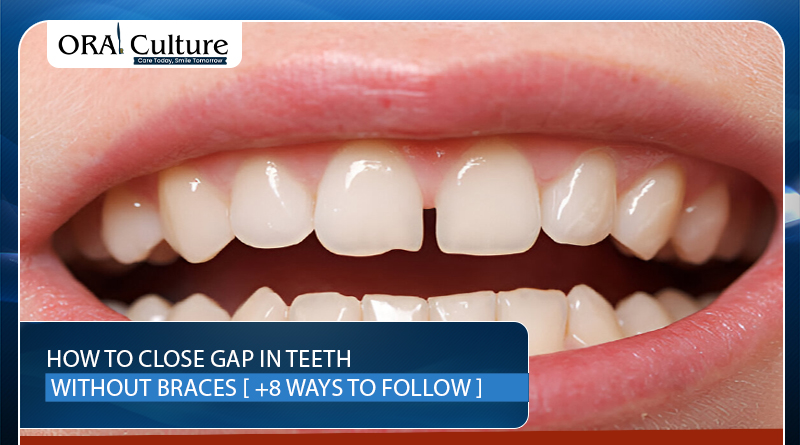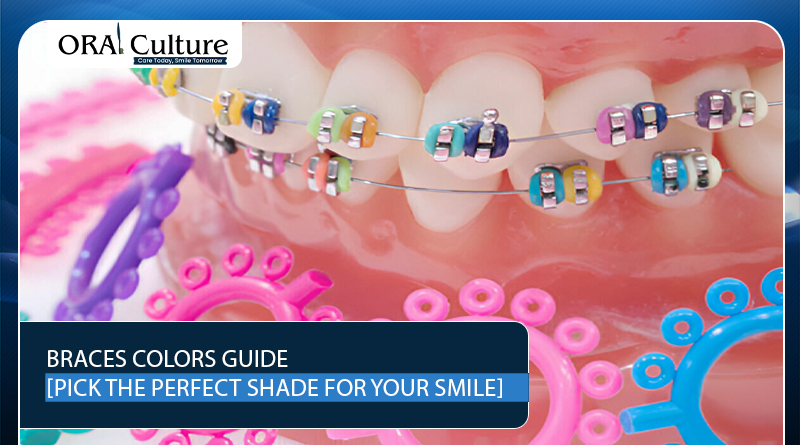10 Ways to Fix Black Spots on Teeth That Aren’t Cavities

Not every black spot on your teeth means you’ve got a cavity. Sometimes it’s just a stain, tartar build-up, or even your tooth’s natural shape. Cavities are only one possible reason, and assuming the worst can cause unnecessary stress. The truth is a lot of these marks are cosmetic or fixable with a simple cleaning. If you have noticed spots and aren’t sure what’s happening, you can always find guidance at Oral Culture. Why Do Black Spots Appear If They Aren’t Cavities? Teeth go through a lot. Food, drinks, habits, and even genetics all leave their mark. And sometimes, those marks look like black dots or lines. Below are the most common reasons behind them. 1. Stains from Everyday Stuff Coffee, tea, red wine, soda, and even dark berries can leave pigments behind. These pigments seep into the tiny pores of your enamel and create spots. 2. Tartar Build-Up Plaque is the soft layer of bacteria on your teeth. Skip flossing, and it hardens into tartar. Once tartar sets, it can darken and turn black over time. No matter how hard you scrub at home, it won’t come off, you’ll need a dental cleaning. And if you’ve ever noticed that your gums bleed when flossing, it’s often linked to this same plaque and tartar buildup. Cleveland Clinic confirms that sugary foods/drinks contribute to plaque (which hardens into tartar), and that smoking or using tobacco products raises the risk of having more tartar. 3. Deep Tooth Grooves Some teeth are born with grooves and pits, especially molars. These grooves naturally look darker because they trap tiny particles and shadows. Even if the enamel is totally healthy, those pits can make the tooth look “spotted.” 4. Old Fillings and Dental Work Amalgam (silver) fillings can darken with age. Sometimes the tooth around it absorbs metal particles, leaving a blackish halo. It’s not decay, it’s just chemistry doing its thing. 5. Trauma or Injury Ever chipped a tooth or got hit in the mouth? The inside of the tooth (the pulp) can bleed. Over time, this makes the enamel look darker or spotty. Even though it’s not a cavity, it’s still something a dentist should check out. 6. Medications and Mouthwash Iron supplements, antibiotics, and mouth rinses like chlorhexidine can stain teeth. These stains usually look patchy and dark, but they don’t mean your enamel breaks down. Curious why rinses sometimes sting? Read about why mouthwash burns and how it affects your oral health. How do you tell if it’s a cavity or just a spot? Not every black spot = panic mode. Here’s how to spot the difference: The bottom line is that only a dentist can give you a sure answer. But these signs help you know when it’s urgent and when it’s just cosmetic. Treatment Options That Really Work Different causes need different fixes. Here’s the breakdown: 1- Surface Stains Whitening toothpaste or professional polishing can clear them up. Think of it like exfoliating your teeth. 2- Tartar Build-Up Only a dental cleaning will get rid of it. Dentists use special tools to scrape tartar off—no DIY shortcuts here. 3- Deep Grooves Sealants are a good option. They’re like a protective coating that seals the pits so food and stains don’t settle inside. 4- Old Fillings Your dentist can replace them with tooth-colored fillings if they look messy or dark. Instant glow-up. 5- Trauma Sometimes root canal therapy is needed if the tooth is dark because of internal bleeding. But in minor cases, cosmetic whitening might be enough. How to Prevent Black Spots (Without Overthinking It) 6- Brush and Floss Consistently The most boring advice is also the most effective. Brushing twice a day and flossing once a day will result in way fewer spots. 7- Rinse After Staining Foods Not saying give up coffee or berries forever. But swishing water after drinking or eating them helps keep stains off. 8- Quit Smoking or Vaping Tobacco is brutal on enamel color. Even vaping juices with nicotine can leave residue. If you’re serious about clean teeth, cutting this habit helps big time. 9- Regular Cleanings Even if you brush perfectly, tartar sneaks in. Seeing a dentist every six months keeps it from becoming stubborn black patches. 10- Use a Straw for Drinks Sodas, iced coffee, or sports drinks hit your front teeth directly when you sip. A straw keeps liquids from sitting on enamel too long. Final Thoughts Black spots on teeth don’t always equal cavities. Sometimes it’s your morning coffee, old fillings, or tartar hanging around. Other times, it’s natural grooves that just look darker. The trick is knowing when it’s harmless and when it needs attention. Don’t stress, but don’t ignore them either. Book a quick check-up and let a dentist figure it out. Most cases are easy fixes and won’t require major treatment. Want more simple guides to oral health? Check out OralCulture.com and keep your teeth in check. People Also Ask 1. Can black spots disappear on their own? Some surface stains can fade with regular brushing or a professional cleaning. But tartar buildup and discoloration from fillings won’t go away without dental treatment. 2. Are black spots always something serious? Not always. Many black spots are just stains or natural grooves in the teeth. Still, some can be early signs of cavities, so it’s best to have them checked by a dentist. 3. How do dentists remove black spots? Treatment depends on the cause. Dentists may polish away stains, clean off tartar, replace old fillings, or use whitening treatments to restore the natural tooth color. 4. Can children get black spots that aren’t cavities? Yes. Kids can develop black spots from iron supplements, certain drinks, or the natural shape of their baby teeth. These aren’t always cavities but should still be monitored.
8 Proven Ways to Close Teeth Gaps Naturally Without Braces

You can close small gaps between your teeth without braces through a mix of natural care, cosmetic dental procedures, and better oral habits. Gaps between teeth (dentists call them diastema) are common. Some people have them since childhood, while others develop them later due to gum issues, tooth loss, or habits like thumb sucking. In many cases, the gap is harmless. But if it affects your smile or makes you self-conscious, you might want to close it. Braces are not the sole choice. Orthodontics is successful, but it is also time-demanding and expensive. Depending on the cause of your gap and your dental health, there are other solutions, some natural, some done by a dentist, and some that combine both. Why do Gaps Appear in the First Place? Understanding the cause helps you choose the right fix. 4 Natural and At-Home Options Let’s be honest…. if your gap is big or caused by bone loss, natural methods alone might not close it. But for small spaces or early-stage shifting, these steps can help prevent the gap from getting bigger and sometimes make it less visible. 1. Dental Exercises Just like you can train muscles, you can train your tongue and jaw. Some people call this “myofunctional therapy.” Research shows it can help with bite alignment and gap prevention, especially in kids and teens. 2. Maintain Healthy Gums Gum disease is a silent cause of shifting teeth. Brushing twice a day, flossing, and rinsing with an antimicrobial mouthwash will help keep gums firm and teeth stable. 3. Oil Pulling Swishing oil (such as coconut oil) in your mouth for 10-15 minutes is an ancient Ayurvedic technique for reducing dangerous germs and improving gum health. Healthier gums mean less shifting. 4. Diet Rich in Minerals Teeth need calcium, phosphorus, and vitamin D to stay strong. Weak teeth are more prone to movement. Dairy, leafy vegetables, nuts, and fish are all great sources. 4 Non-Braces Dental Treatments If your gap bothers you and you want a faster fix, dentists offer options that don’t involve metal wires. 1. Dental Bonding A tooth-colored resin is put to the sides of your teeth to close the gap. It is painless, quick, and lasts several years. If you have a 1-2 mm gap, bonding can close it in a single visit. 2. Veneers Thin porcelain or composite shells are placed in front of your teeth. They adjust the size and shape of your teeth to eliminate gaps. 3. Clear Aligners These are not traditional braces, they are transparent trays that gently move teeth over months. They’re removable and almost invisible. 4. Frenectomy If your gap is caused by a thick gum tissue (frenulum), a dentist can remove or reshape it. This often helps close the gap permanently, especially in kids. Combination Approach Some people use a mix of natural care and cosmetic treatments. For example: This way, you address both appearance and long-term stability. Sarah, 27, had a small gap due to tongue thrusting. She learned myofunctional exercises and switched to a high-mineral diet. After 9 months, her gap reduced by almost half without braces. She later chose bonding to perfect her smile. It shows that combining natural care with professional treatment can give both quick and lasting results. Important Safety Note!! Never try to close gaps by yourself using rubber bands or “DIY braces” you see online. These can cause gum injury, tooth loss, and even bone damage. The American Association of Orthodontists has reported cases where people lost healthy teeth due to unsafe home fixes. How Long Does It Take to See Results? Final Note! You can close a teeth gap without braces, but the best method depends on how wide the gap is and how healthy your teeth and gums are. Begin with natural care to keep your mouth strong, and consider safe cosmetic options if you want quicker results. Your smile is one of a kind, so choose a solution that protects its health as much as its appearance. For more natural dental care advice and reliable products, visit Oral Culture. Frequently Asked Questions 1. Can I close a gap without braces? Yes. Small gaps can often be closed naturally or with cosmetic treatments such as bonding, veneers, or clear aligners. Larger gaps may still require orthodontic treatment. 2. Is dental bonding a safe option? Yes. Dental bonding is non-invasive and reversible, but it may need to be replaced every 5–10 years as it wears down over time. 3. Do natural methods work for everyone? Not always. If the gap is large or caused by missing teeth, natural methods alone may not fully close it, and professional treatment might be necessary. 4. Can a gap come back after it’s been closed? Yes. If the underlying cause, such as gum disease or tongue thrusting is not addressed, the gap can reopen over time.
5 Tips to Choose the Perfect Braces Colors

Getting braces doesn’t mean sticking with a boring metal look. One of the best parts about having braces is picking colours that match your personality, style, or even your mood. Brace colors are more than just a cosmetic choice; they can make the experience much more fun! Here’s everything you need to know about choosing the right braces colors so you can smile with even more confidence. Why Are Braces Bands Colourful? When you get braces, tiny elastic bands called ligatures are placed around each bracket to hold the wire. These bands come in various colours, from soft pastels to bold neons, letting you customize your smile however you like. Whether you want your braces to blend in or stand out, colours give you a way to express yourself during your orthodontic journey. Best Braces Colors for Every Style Not sure where to start? Here’s a quick breakdown of colour ideas depending on what vibe you’re going for: Classic and Clean: Clear, silver, or white bands are low-key and subtle. Bold and Bright: Electric blue, neon green, or bright pink make a statement. Cool and Calm: Navy, teal, or forest green feel mature and stylish. Playful and Fun: Purple, aqua, or bubblegum pink are cheerful and vibrant. Seasonal Themes: Pastel colors for spring, orange and black for Halloween, or red and green for the holidays. How Do You Choose the Right Braces Color for You? It’s up to you to pick which brace color is best for you, but here are some simple guidelines to get you started: 1. Skin Tone Is Important Your skin tone can make certain colours pop even more. If you have a warmer skin tone, meaning you tan easily or have golden, olive, or darker undertones braces colors like red, orange, gold, and forest green usually look fantastic. These earthy shades complement your natural glow. On the other hand, if you have a cooler skin tone, lighter skin that burns easily, or pink or blue undertones, you might look best with colors like blue, purple, pink, or silver. 2. Think About Your Wardrobe Take a quick look at your closet. The colours you wear most often can guide you toward the perfect braces band shade. If you wear a lot of neutral tones like black, white, gray, or navy, almost any braces colour will work, but bold colours like royal blue, emerald, or fuchsia can add a fun pop. If your wardrobe is already full of bright colours, you might want to choose a braces colour that fits the theme (like turquoise or bright pink) or go with subtle shades to balance things out. 3. Highlight Your Eye Colour Your eyes are one of your most striking features, and the right colour of braces can make them pop even more. If you have green eyes, shades like emerald, forest, or light green will beautifully enhance them. If you have blue eyes, go for navy, sky blue, or even silver bands to make your eyes sparkle. For brown eyes, you have lots of flexibility; rich colours like purple, teal, and dark green look especially striking. 4. Avoid Certain Colours Some colours might not give the effect you are hoping for, no matter how good they sound in theory. White can get stained easily, particularly if you consume a lot of tea or coffee or eat many colorful foods. By contrast, they also tend to make your teeth appear less white. Yellow bands are risky because they can highlight any yellowish tint in your teeth, making them appear stained even if they’re clean. Black bands can sometimes mimic the look of food stuck between your teeth, which isn’t the effect anyone wants. When in doubt, pick colours that brighten your smile rather than dull it. Deep, saturated shades like dark blue, maroon, or vibrant purple usually work best. 5. Match Your Mood or Events Wearing braces can be fun to flaunt your individuality or commemorate key occasions. Do you have a special event coming up, like prom, a birthday, or graduation? Choose brace colors that match your dress, your school colors, or even a holiday theme. Feeling festive during the holidays? Pastel colors for Easter, orange and black for Halloween, or red and green for Christmas are all entertaining choices. Or maybe you want your braces to match your mood, bright colours for an energetic vibe or cool blues for a more laid-back feel. Most Popular Braces Colors Right Now Some colours never go out of style when it comes to braces. Based on what people are loving lately, here are the trending picks: Royal Blue: Eye-catching but still sleek. Teal: Fresh and modern. Light Pink: Soft and subtle. Red: Classic and bold. Black and Gold Combos: Trendy and unique. Some even go for rainbow colours, each tooth a different shade, for a playful and creative look! Colour Combos That Always Look Good Want to level up your braces game? Try these colour combinations: Blue and Green for a beachy vibe Red and Black for a bold contrast Pink and Purple for a fun, playful mix Light Blue and Silver for a chill, icy look Orange and Blue for a sporty, energetic feel The possibilities are endless, and most orthodontists are happy to help you mix and match colours until you find your perfect combo. Tips for Keeping Colour Bands Fresh Bright colours can fade or stain over time, especially if you drink a lot of coffee, tea, or soda. Here’s how to keep them looking fresh: Brush and floss regularly Rinse your mouth after drinking anything dark Avoid foods that stain, like curry or berries Get your bands changed at every adjustment appointment Fresh bands, fresh smile! When to Change Your Braces Colors? You can pick a new shade or combination each time you go in for a braces adjustment (usually every 4–8 weeks). This means you can change colours regularly to celebrate seasons, holidays, or mood swings. It keeps the braces experience a little
